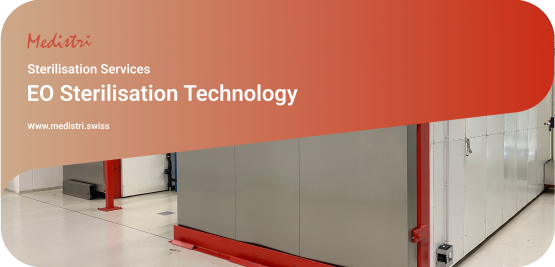(Download: EO Sterilisation Technology in PDF by Medistri)
At Medistri, we’re focused on using our resources to combat climate change. We believe our commitments are both ambitious and necessary. To achieve our objectives, we focus on scalable innovation. Designing and implementing new technologies, mobilising financing structures, and rapidly deploying renewable energy.
Ethylene oxide (EO) is a globally recognised sterilisation method that since the 1960s has proved effective to sterilise healthcare supplies for the world’s patients. The use of ethylene oxide as a sterilisation method entails an increased focus on human safety and environmental complexities.
As an alkylating agent, EO disrupts the metabolic and reproductive functions of microorganisms. It has the ability to penetrate packaging that is breathable, thereby reaching all surfaces of the product that are accessible and ensuring the necessary level of sterility (SAL).
EO sterilisation is a popular method of sterilisation for medical devices and pharmaceutical products. It is important for companies to use EO sterilisation because it is effective against a wide range of microorganisms, including bacteria, viruses, and fungi. This ensures that the medical devices and pharmaceutical products are safe for patient use.
At Medistri, we have invested our resources in finding smarter systems, protocols & validation methods to reduce, optimise and eliminate ethylene oxide emissions. Although there are local and federal regulations that have been put in place for such purposes, we believe in setting up even higher internal standards to ensure the health and safety of our communities and future generations.
We’ve installed complex, leading-edge, high-performance gas treatment technology systems. Our systems are in full compliance with local and federal legislation and they allow for an almost 100% complete reduction of EO emissions.
Fundamentally, our two-step technology forces the gas to pass through our Peak Shaver followed by an injection of the gas residuals through our Catalytic Burner. Our Peak Shaver reduces gas concentration and our Catalytic Burner eliminates the gas.
At Medistri, we’ve also invested our resources in order to offer a better alternative to the traditional sterilization method. We’ve popularised & offered a smarter alternative to the market called the “ Biological Indicator/ Bioburden Approach”. Let’s compare it to the traditional “Overkill Approach”.
The traditional Method Overkill Approach is based on the performance of 3 half-cycles with total kill of Biological indicators and 1 short cycle with some growths. Here’s the advantages & disavantages:
👍 Conservative Method.
👍 Already known in the market, easy to defend and explain to customers and auditors.
👍 The cost of validation is known.
👎 The quantity of EO gas used is too high as base on Biological indicators 10^(-6) with high contamination.
👎 Cycle length too long: It can reach up to 20 hours for certain products with additional degassing time.
👎 Not environmentally friendly, not a sustainable process.
On the other hand, Biological Indicator/Bioburden Approach requires that the bioburden stays constant over time and less resistant than the biological indicators used. For completing this approach several cycles with different exposure times are performed in order to find the lethal rate. Here’s the advantages & disavantages:
👍 Cycle length is shorter as there is less aeration time because less gas is used.
👍 EO gas quantity will be reduced as bioburden is lower than the biological indicators
👍 The residue in the products will be decreased, faster release of products - Costs of cycle decreases.
👍 Sustainable & environmentally friendly method.
👍 During this method by the performance of several cycles comparison of products and identifying the worst-case product could be clearly demonstrated.
👎 Requires good control of the bioburden trend.
👎 Not fully known in the market.
👎 More cycles to perform.
👎 The validation price might be higher than the traditional overkill method.
At Medistri, we follow the ISO 11135 for our EO Sterilisation process as it can help simplifying the production, ensures product consistency and safety, and promote global collaboration and compatibility.
ISO standards can also help companies meet customer requirements, improve customer satisfaction, and comply with regulatory requirements.ISO 11135 specifies the requirements for the development, validation, and routine control of an EO Sterilisation process in both industrial and healthcare facility settings. Also, it acknowledges the similarities and differences between the two applications and provides guidance on how to establish and validate an EO sterilisation process.
Medistri SA is equipped with 6 EO Sterilisation chambers each with capacities up to 16 palettes. Our chambers have been engineered to allow you to sterilise loads up to 200cm of height, allowing you to maximise the size of your final production loads, and reduce costs. Medistri can currently sterilise more than 90'000 palettes annually using its EO Sterilisation infrastructure. And we're always working towards making this number larger.
🎯 To learn more about Medistri’s EO Sterilisation Technology, visit on our website here or directly contact our team at contact@medistri.swiss.
- The Medistri Team
#Medistri
